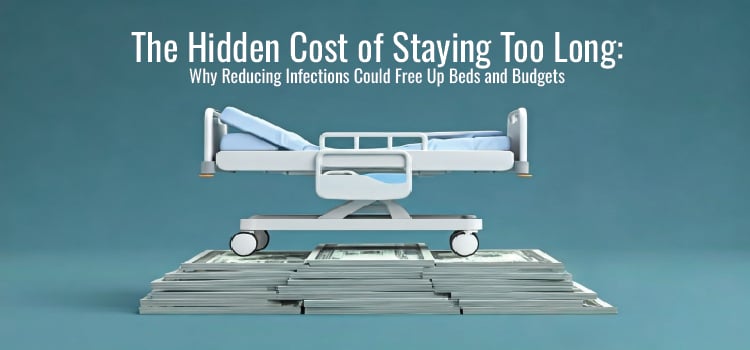The Hidden Cost of Staying Too Long: Why Reducing Infections Could Free Up Beds and Budgets

Hospitals across the country are feeling the pressure. In recent years, the number of staffed beds has dropped significantly, while the demand for care continues to grow. Fewer resources and sicker patients are on a collision course, and the strain is only expected to intensify in the coming decade. Amid this challenge lies an often-overlooked opportunity: tackling the extra time many patients spend in the hospital after they no longer need to be there. These delays, known as avoidable hospital days, are expensive, risky, and largely preventable. In today's post, we will look at how reducing unnecessary extra hospital days can improve the entire US healthcare system.
When “One More Day” Comes at a Price
Every unnecessary day a patient stays in the hospital costs more than just money. It also increases their exposure to the very real dangers of hospital-associated infections (HAIs). Infections like MRSA, C. difficile, and surgical site infections are more likely to occur the longer a patient remains in a clinical setting. And when they do, they often lead to prolonged recovery, additional treatments, and sometimes, readmission.
This creates a feedback loop: patients stay longer and become more vulnerable to complications, which in turn can extend their stay even further.
Millions of Extra Days, Millions of Risks?
Data shows that many hospitals are unintentionally extending patient stays by nearly half a day on average, adding up to millions of excess hospital days every year nationwide. While the causes vary (from delays in discharge planning to gaps in communication), the consequences are consistent: higher costs, increased burden on clinical staff, and a greater likelihood of preventable infections. HAIs also increase length of stay (LOS): A recent study puts the excess LOS due to HAIs at 7.8 days and that the median LOS for patients with an HAI was 30 days compared to just 3 days for a patient without an HAI.
Addressing this issue isn’t just about improving efficiency—it’s about improving safety.
A Better Path Forward Is Possible
Reducing avoidable hospital days doesn’t require reinventing the care model. It starts with minimizing the risks that keep patients from recovering and being discharged on time. Strengthening infection prevention efforts such as through better protocols, staff training, and biocidal materials such as EOSCU, can play a powerful role in shortening recovery times and reducing complications.
Fewer infections mean faster recoveries. Faster recoveries mean fewer days in the hospital. And fewer days free up resources, ease staffing burdens, and open beds for the next patient in need.
More Than a Metric
Avoidable days are often treated as a data point in operational reports. But behind every number is a person: Someone eager to return home, someone whose health could turn on a single preventable infection. By seeing length of stay not just as an efficiency metric but as a patient safety issue, healthcare leaders can take meaningful steps toward safer, smarter care.
![EOScu Logo - Dark - Outlined [07182023]-01](https://blog.eoscu.com/hubfs/Eoscu_June2024/Images/EOScu%20Logo%20-%20Dark%20-%20Outlined%20%5B07182023%5D-01.svg)

![[infographic] 3 Reasons Patients are Vulnerable to HAIs Download and share!](https://no-cache.hubspot.com/cta/default/216314/interactive-178382222189.png)



